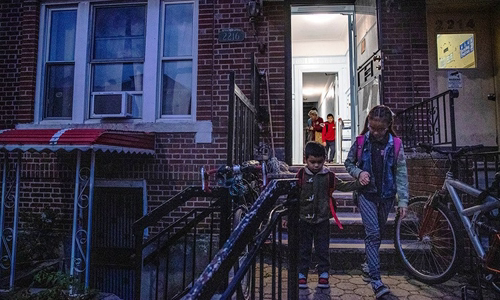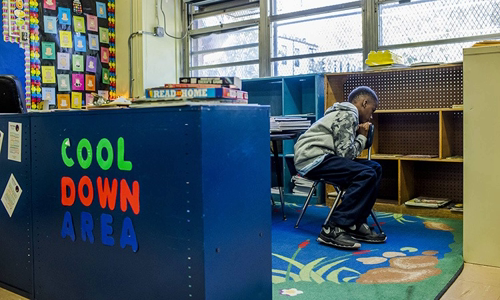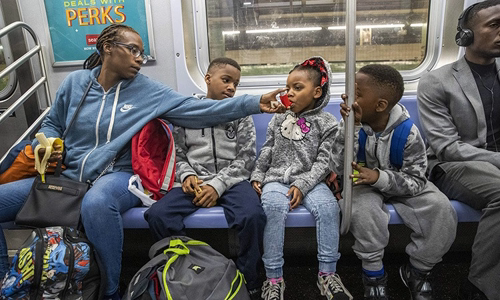More than 114,000 children in New York struggle to live in cramped rooms, schools are the only stable place.
Darnell, 8, lives in a shelter for the homeless in New York City, taking the subway every day for more than 24 km to school. Sandivel (often called Sandy), a 10-year-old homeless child, had to move 7 times in just 5 years and had to share the cramped bedroom with his mother and 4 brothers.

Sandy (right) holding his brother's hand leaves the motel in Bensonhurst, Brooklyn District, New York, USA, in October Photo: NY Times
The number of school-aged children in New York living in shelters or boarding houses has increased by about 70% within a decade. The estimated number of homeless students living in shabby, unsafe rooms for several months before moving to another location was estimated to be 114,085. Schools are probably the most stable place for them.
Following Darnell and Sandy from dawn to dusk, New York Times reporters had the opportunity to better understand the daily lives of two "homeless" children.
Sandy usually wakes up before 6 am every day. In the cramped bedroom painted in blue, pasted with posters of former President Barack Obama and Mary, Sandy shares a bed with her mother, Maria, and her youngest brother, Jonni. The remaining three brothers slept together on a cushion placed on the floor. Other spaces such as kitchen and bathroom have to share with a family of 4 other people living in the same house.
"A lot of people live here, but they treat me very well," Sandy said.
The places Sandy used to live in were not so comfortable, the place where murder was almost happening, the place where the people in the house did not use the kitchen made Sandy and her mother eat in the bedroom.
Sandy's lunch today is a bag of cheesecake, a snack that my mother bought a lot at Costco supermarket. The five children prayed and walked out of the house, an hour before their eyes, from Bensonhurst, Brooklyn to the Lower East Side, Manhattan.
Maria is trying to find a stable job when the small amount of savings is exhausted. She has to take care of 5 children and cover the rent of 700 USD per month.
Maria had to take her children to school and pick them up every day, so she needed a fixed-time day job.
Maria's children entered public school 188 after she fled a violent marriage and moved to a shelters for women like her in Manhattan. "My mother and I got through it together, and forgot about everything," Maria shared.
Meanwhile, in the Queens district east of New York City, little Darnell was late to the school bus by less than 6:30. Sherine, Darnell's mother, called after the bus but it didn't stop.
Last night, the whole family was at the police station because Sherine's phone was stolen. They returned home past midnight and had only taken a few hours' nap.

Darnell sat alone in a classroom at Public School 76 in Manhattan, New York, USA Photo: NY Times
Delayed, Darnell had to take a 90-minute subway ride from the tabernacle in Jamaica in Queens to school in East Harlem in Manhattan.
Darnell's residence was very far from school, but it was safer and more spacious than the cramped room at his grandmother's house where the boy used to live with his mother and two younger siblings. Darnell is in 4th grade and has changed schools 4 times.
For a long time, Sherine had never had a home of her own. She was raised by her grandmother until she was 12 and had to be independent later. At the age of 18, she moved to a shelter, and ever since, she has been living in such shelters.
Sherine, 35, has eight children, five of whom are no longer living after she left her violent husband. Sherine was recently hired as a home health worker, and hopes to have the money to buy a home soon.
"No child should have grown up in a shelter," Sherine said.
Returning to Sandy, the afternoon English class is the best place for her. Sandy loves his teachers very much, always writing fully, meticulously, and recording all the books he has learned.
However, Suany Ramos, Sandy's school principal, is still very worried about her. Ms. Ramos was disappointed that this school had only one social worker, while about half were homeless students.
"Nobody cares about Sandy and says 'She needs help'," said Ms. Ramos, worried that Sandy would be hurt when she was cared for less.
At the call of many activists, New York Mayor Bill de Blasio decided to add 31 social workers to care for homeless students this school year, bringing the total number of social workers in school to 100 people. The cost for these 100 employees is about $ 14 million a year, while New York's annual education budget is $ 24 million.
However, at 76 public school, things did not seem easy for Darnell. The boy was met by principal Charles DeBerry in private after a scuffle with a group of soccer friends. Mr. DeBerry said that it is necessary to have more psychological counseling to help about 30% of homeless students at this school.
After lunch, Darnel urged a classmate so he was pushed to the floor. Darnell's teacher called a psychologist when he saw him crying in class.

Sherine (left) and 3 subway rides to school in Queens, New Yorks, USA Photo: NY Times
"I haven't touched him," Darnell said.
Then both boys were asked to apologize to each other. Darnell told his psychologist that he was bored and didn't want to go back to class.
School was probably not an interesting place for a fourth-grade boy like Darnell when he had difficulty learning, especially reading. A statistic shows that more than 70% of homeless students failed in the English exam last year, and less than 60% graduated from high schools in the city.
Darnell only found inspiration in computer science, where the boy showed agility with math exercises like pairing or filling out a multiplication table. For the rest of the afternoon class, Darnell just sat in a chair and nearly got himself into another scuffle. After class, Darnell had three more hours of extra classes, but he only had football in his mind.
After the school day, Jesus, Sandy's 15-year-old brother, went to the 188B Public School's physical education school to pick them up and have them bathe here before returning. For these kids, the bus is like a library where they can do homework.
The children met and hugged their mother in Union Square and then returned home by subway. Maria handed a large Kit-Kat and a bottle of soft drink to 5 children.
At 6 PM, Darnell was ready with his younger brother, Thomas, to prepare to practice rugby. Darnell listens to the coach and listens carefully to each instruction before training.
Sherine always accompanies her kids, picks them up at school, fixes her clothes and takes them to the training ground a few blocks away. After years of being bullied by friends, Darnell now has his first friends to play football.
"I'm glad he is safer now, but I hope to have his own home so his friends can play." Sherine shared and her voice became choked. "I feel like a bad mother. I should have given them everything they needed." This is also the heart of thousands of homeless families in New York.
At the end of the session, the Darnell brothers were tired and hungry. Sherine and her children returned home and hoped that some of the food would still be left to them.
Meanwhile, Sandy was watching the sky turn dark and hoped the whole family could sit and watch "Cake Boss" or "Tom and Jerry" on a small television set on two closets.
After that, they will all fall asleep and wake up early tomorrow to start a new day like any other.



 PMARodriguez
PMARodriguez








